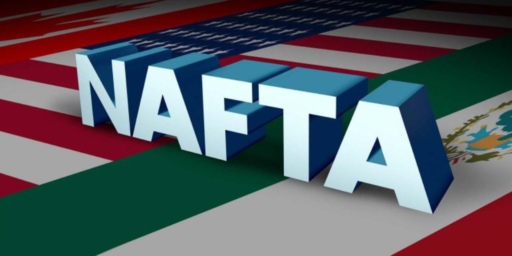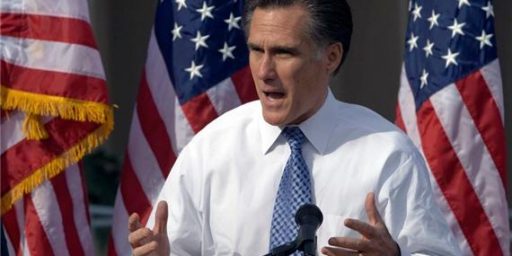Estimates of the Trade and Welfare Effects of NAFTA?
I am going to construct a complicated mathematical model of the economy, and then I'm going to calibrate it using some actual data, and in the end I will be able to tell everyone how much better or worse off they are given various changes in the economy. And it will be totally and completely true. Trust me, it's math and therefore science.
My co-blogger Dave Schuler pointed me to this paper on NAFTA. The title is the same as the title of this post, but without the question mark.
Dave cited this interesting claim from the abstract,
We find that Mexico’s welfare increases by 1.31%, U.S.’s welfare increases by 0.08%, and Canada’s welfare declines by 0.06%.
Why is this interesting? Well, it claims to tell us how much the overall welfare in the U.S. increased as a result of NAFTA. I found this to be rather startling. I find it startling because to do this the authors would need some measure of welfare for each person in the U.S., a utility function if you will. Here is the thing, I don’t even know what my utility function is. I could say it is U(x,y) = a*log(x) + (1-a)*log(y) which would be a Cobb-Douglas utility function. But is that really my utility function? To be quite honest I don’t know. Nobody knows what their utility function is nor could they really write it down.
In fact, that is exactly the type of utility function the authors assume for everyone. A Cobb-Douglas utility function over J final consumption goods with a sequence of exponents denoted (abusing notation a bit here) of a(j) where the sum of these J exponents equals one. In other words, a Cobb-Douglas utility function with constant returns to scale, that is if you double all of the J final consumption goods you double your utility. This is rather restrictive, but they probably chose it to ensure there would not be any issue with increasing returns to scale. In other words, they chose this utility function, and later the production function, for mathematical tractability, vs. actually trying to measure real life changes in welfare for consumers.
Now, what is one reason why we might see a small increase in welfare, setting aside this issue of is that really the utility function of every American. Well suppose you have the following function f(x) = log(x) and suppose you go from 100, too 200 for x. How big a change is there in f(x)? You go from 2 to approximately 2.3 or you get an almost 15.1% increase in welfare…for a doubling of your input/consumption good. In fact, given this functional form for utility we can derive the functional form for marginal utility, it is 1/x. As X gets larger the marginal impact on utility will get smaller and tend towards zero in the limit. So, given the assumptions of the model it is not that startling to see the percentages quoted above. The U.S. consumer probably consumes far more of the various J final consumer goods than Mexican consumers. But of course, why should Mexicans and Americans have the same utility functions?
Now, what about production in this paper? Interestingly enough the authors do allow for different types of intermediate goods, but labor is simply labor. All labor is the same. College graduate with a degree in chemistry, the same as the high school dropout working at the car wash. Each type of labor can be interchanged with zero loss to productivity. Instead of treating capital as one big amorphous mass that can be moved around quickly and with no loss in productivity from industry to industry this is the assumption with labor. In fact, it also holds between countries too from what I can see. Labor between the N countries is entirely fungible. Lets skip over cultural norms, language barriers and the like. And yet again the authors assume constant return to scales and perfect competition.
That last one is a bit of doozy by the way. Perfect competition means not just that there is competition, but that it is perfect. That is everyone knows everything about everything. We don’t have to worry about incentive problems or informational asymmetries or even whether or not consumers know what their utility function is or producers of intermediate goods knowing their production function or their cost functions, etc. Everyone knows it all at all times.
From there the authors go on to derive equilibrium conditions and results. However, even these, while undoubtedly mathematically true, are dubious. Equilibrium in economics is kind of a fiction. What happens at equilibrium? Nothing. There is a joke about economists; a finance guy and an economist are walking down the street. The finance guys says, “Look, $20 on the ground, lets pick up and go have lunch.” The economist responds, “Ridiculous, in equilibrium somebody would have already picked it up, so it can’t be there.” In equilibrium how much food would in the grocery store? None. Why? Markets have cleared, quantity supplied equals the quantity demanded. Nothing left to put on the shelves. There would be no gasoline at the gas station, no clothing at the department store. The point is that economies are rarely if ever at equilibrium. Deriving equilibrium conditions may not be totally useless in terms of mathematical modelling, but basing analysis off of equilibrium conditions probably is.
And while the authors do estimate some trade elasticities their overall model is not empirically estimated. It is calibrated and then simulated. Much like the real business cycle and other macro economic models out there. While I suppose these can be interesting, I guess, the problem is the results can be highly misleading like that 0.08% welfare gain from NAFTA for Americans. This is treating their model as if it were a literal representation of reality. Clearly it isn’t.
Note, none of the numbers the authors present are actual real world numbers. They are all based off of their model simulations. Further, the model is simple, and actually that is not all that bad. Trying to have extremely complicated models can quickly become intractable and leave us unable to learn anything at all. But to look at these results and say, oh 0.08% for the U.S. therefore the U.S. got pretty much nothing from NAFTA is a gross misinterpretation of this model. That number is derived from this highly stylized and simple model. It is not based on trying to parse out what actually happened in the the U.S., Mexican and Canadian economies.






Good post, Steve. The only observation I would make is that this:
Doesn’t mean that the calculation isn’t correct. It means it could be right, too low, or too high.
Which is the actual case is important, especially because some people actually lost their livelihoods as the consequence of of the trade pact. Just because free trade should result in a net benefit doesn’t necessarily mean that managed trade–which is what our “free trade” pacts have been–will result in a net benefit large enough to justify that or even in any net benefit at all.
Given that most in this audience are not economists or mathematicians, you would need to explain the terms you use if you want most of us to understand your post. For most of us, utility is more commonly seen in the context of utility knife or utility infielder and welfare has an instant connotation/connection with social welfare programs. Just something to think about…
OK, some economists did some economics and you don’t like it. So what’s your estimate of the benefit of NAFTA?
http://www.cfr.org/trade/naftas-economic-impact/p15790
Mr Verdon, you are such an idiot.
@JohnMcC:
From the article you cited:
The difference between .5% and .08% is significant but in either case the benefit is pretty darned limited and if not widely distributed should give at least some pause.
@Dave Schuler: Respectfully, when the subject of the sentence if the U.S. economy there is a big difference between the modifier ‘0.5%’ and the modifier ‘0.08%’. It is a difference big enough to build infrastructure, fund state universities completely and introduce new industry to regions.
Given ten years which I think is the usual horizon for budget planning at U.S. Gov’t levels it’s the difference between TVA or no-TVA.
A textile plant closed for years is being upgraded, remodeled, and reopened with around 250 workers being hired. Another manufacturing firm is looking around, considering moving here from up north. I don’t know what’s behind it, but we’ll take it ! People around here are now hopeful and upbeat.
NAFTA allows industries on both sides of the Rio Grande to be more competitive against their Asian counterparts. Manufacturing plants in Michigan and in Alabama can use parts and components produced in Mexico to be more cost-effective and Mexico has one of the most competitive economies in Latin America thanks to competition and integration with the American Economy(it´s one of the reasons why Cancun and Acalpuco offer better cost-benefit to tourists than Rio)..
The United States is not the only country on Earth, and competition from Asia is fierce.
I would guess that without NAFTA the United States is less competitive with Asia, so, that would mean less jobs. By the way, Europe would probably gain a lot of manufacturing jobs had they done the same kind of deal in Northern Africa or Turkey.
@Dave Schuler:
I would say it is pretty much wrong. A point estimate is almost always wrong, or more accurately almost surely wrong.
The point is that 0.08% is meaningless outside the context of this model and this model is not the U.S. economy or any economy. Pointing to this and saying something about NAFTA is not too dissimilar from saying you can say something about trains because you have a model train in your basement. There might be some insights one can draw from these models, but the welfare effects are probably not one of them.
As for picking winners and losers that is never a good thing. If we could pick winners and losers with ease we’d all be billionaires and the term would mean nothing. And yes, there are negative effects of changes in the patterns of trade and exchange. But that is always happening. The idea of managing this to minimize such effects is very problematic, especially if you are going to try and “save” the jobs.
@gVOR08:
No, more like people were mistakenly pointing to this highly mathematical model and concluding it meant something significant. If I consturct a mathematical model representing your welfare, calibrate it real world data and then run simulations are you going to believe the results? I would hope not. I also hope you wouldn’t take the results and use them as a guide in making actual decisions.
@SKI:
That is just it. Most people will read the abstract and go, “Oh, small improvement. No big deal.” They probably can’t read the rest of the article as it is not really written in English as most of us understand it. This is CGE model, a computational general equilibrium model, a model that is supposed to tell us how much better off everyone in the U.S., Canada, and Mexico are because the model said so. But the model is not the economy. It is a simplified facsimile at best.
@JohnMcC:
What a simplistic analysis. For example Dean Baker’s view that the trade costs 600,000 jobs. How does he get that number? He looks at just one aspect of it. The EPI looks at the direct impact but ignores the indirect impact. If people are getting goods at lower prices that means they have more income to spend on other goods which can increase employment. Further, could NAFTA be a reason why immigration from Mexico is at a low, instead of heading north to look for a job Mexicans are finding them in Mexico? Is that a good thing for the U.S.? People complain about Mexicans coming north and taking jobs. But when you change the economic conditions in Mexico so there are now good jobs there…they are stealing those jobs too. Seriously, most posters here at OTB seem to suffer some rather severe schizophrenia.
@JohnMcC:
About those big projects…yeah they are called megaprojects and they kinda suck too.
@Steve Verdon:
If I needed to make a decision, like a president deciding whether to support trade deals, and that was the best estimate available, of course I’d use it. What else would one do? Do you have a better estimate?
You’re reminding me of a discussion with a conservative friend a few years ago. He objected to someone estimating Ohio tax revenues would change by X due to a small rate change Y. On probing, it turned out he couldn’t accept an estimate of anything (he was a high end tax accountant). He was completely unable to deal with provisional information. There were only concrete facts or nothing. It’s a trait I sometimes think is common among conservatives.